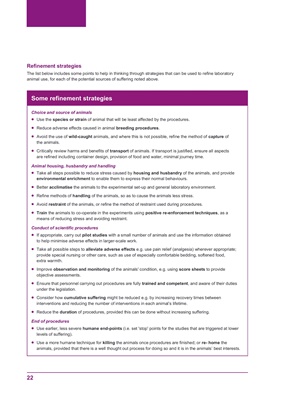
22
Refinement strategies
The list below includes some points to help in thinking through strategies that can be used to refine laboratory
animal use, for each of the potential sources of suffering noted above.
Some refinement strategies
Choice and source of animals
Use the species or strain of animal that will be least affected by the procedures.
Reduce adverse effects caused in animal breeding procedures.
Avoid the use of wild-caught animals, and where this is not possible, refine the method of capture of
the animals.
Critically review harms and benefits of transport of animals. If transport is justified, ensure all aspects
are refined including container design, provision of food and water, minimal journey time.
Animal housing, husbandry and handling
Take all steps possible to reduce stress caused by housing and husbandry of the animals, and provide
environmental enrichment to enable them to express their normal behaviours.
Better acclimatise the animals to the experimental set-up and general laboratory environment.
Refine methods of handling of the animals, so as to cause the animals less stress.
Avoid restraint of the animals, or refine the method of restraint used during procedures.
Train the animals to co-operate in the experiments using positive re-enforcement techniques, as a
means of reducing stress and avoiding restraint.
Conduct of scientific procedures
If appropriate, carry out pilot studies with a small number of animals and use the information obtained
to help minimise adverse effects in larger-scale work.
Take all possible steps to alleviate adverse effects e.g. use pain relief (analgesia) wherever appropriate;
provide special nursing or other care, such as use of especially comfortable bedding, softened food,
extra warmth.
Improve observation and monitoring of the animals' condition, e.g. using score sheets to provide
objective assessments.
Ensure that personnel carrying out procedures are fully trained and competent, and aware of their duties
under the legislation.
Consider how cumulative suffering might be reduced e.g. by increasing recovery times between
interventions and reducing the number of interventions in each animal"s lifetime.
Reduce the duration of procedures, provided this can be done without increasing suffering.
End of procedures
Use earlier, less severe humane end-points (i.e. set 'stop' points for the studies that are triggered at lower
levels of suffering).
Use a more humane technique for killing the animals once procedures are finished; or re- home the
animals, provided that there is a well thought out process for doing so and it is in the animals" best interests.